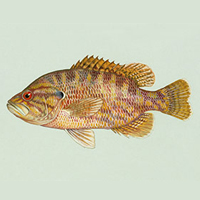Warmouth
Scientific name: Lepomis gulosus

Cover photo credit: US Fish and Wildlife Service
Status
Endangered
"Endangered" means the species lives in the wild in Ontario but is facing imminent extinction or extirpation.
Date added to the Species at Risk in Ontario List
The warmouth was already assessed as a species of special concern when the Endangered Species Act took effect in 2008. On June 15, 2016 it was listed as endangered.
Read the assessment report (PDF)
What it looks like
The warmouth is a small sunfish about 30 centimetres long. It has a round, deep body with a long dorsal fin, comprised of both soft and spiny rays. The warmouth is usually yellow-brown to golden on the top and sides and paler on the underside. Often the Warmouth has five dark lines extending from the snout and eye and radiating across the cheek. It has a large mouth with a projecting lower jaw and a band of tiny teeth on the tongue.
Where it lives
The warmouth, a warm-water species, prefers silt-free marshes, ponds and lakes with abundant aquatic plants and mucky bottoms. Males gather in loose colonies in spring and early summer and build nest depressions for the females to lay eggs. The males then guard their nest and eggs fiercely. Spawning occurs at one to two years of age, and females lay 800 to 34,000 eggs depending on their size. They can live up to eight to nine years.
Where it’s been found in Ontario
The warmouth is found in the eastern United States, from the lower Great Lakes south to Florida, and west to Kansas. In Canada, the species has been reported in Lake Erie at Rondeau Bay, Long Point Bay and Point Pelee.
What threatens it
The warmouth was first recorded in Ontario in 1966 and may be a relative newcomer to the province. Alternatively, it could have gone undiscovered because it was always rare here. Habitat loss due to the draining of wetlands for agricultural and urban development is the main threat to this species, though current Ontario populations live in protected areas and are in no immediate danger.
Action we are taking
Endangered species and their general habitat are automatically protected
What you can do
Report a sighting
- Report a sighting of an endangered animal or plant to the Natural Heritage Information Centre. Photographs with specific locations or mapping coordinates are always helpful.
Volunteer
Volunteer with your local nature club or provincial park to participate in surveys or stewardship work focused on species at risk.
Be a good steward
Private land owners have a very important role to play in species recovery. You may be eligible for stewardship programs that support the protection and recovery of species at risk and their habitats.
Report illegal activity
Report any illegal activity related to plants and wildlife to 1-877-TIPS-MNR (847-7667).
Quick facts
- the warmouth feeds on small fishes, crayfishes and aquatic insects, and is likely to eat proportionally more fishes than most sunfishes.
- the warmouth can be mistaken for the more common rock bass, however, counting the number of anal spines will easily distinguish the two (Rock bass having six, and warmouth having three).